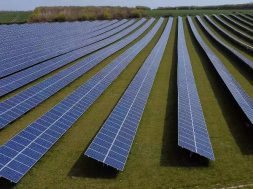
And now, bifacials make a dent
That solar power prices have fallen to historic lows — to ₹2.44 a kWhr, in one instance, well below the prices of conventional energy — seems to have done little to deter the optimists from anticipating further declines. The International Energy Agency (IEA) believes that solar prices could come down by as much as 60 per cent from today’s levels over the next decade — not counting in any major technological breakthrough. So what does the solar industry have up its sleeve? Well, for one, ‘bifacial modules’. These special solar panels have in the recent few years been migrating from the pages of technical literature onto grounds and rooftops. Today, there is hardly any solar trade magazine that brings out an issue without news of bifacials — a new plant being set up here, an order won there, among other posts. The time of bifacial modules has begun. “Bifacial modules have started gaining momentum worldwide and India presents a good case for its adoption,” says Dr Arulkumar Shanmugasundram, Chief Technical Officer at Tata Power Solar.
Positive prognosis
Simply put, bifacial modules are those that produce electricity from both sides — front and back — the former from the sun and the latter from reflected light. Various descriptions of their economics are floating around, but the median theme is that the net cost-benefit is positive. Ivan Saha, who heads manufacturing at Vikram Solar, says that for bifacial modules you would have to shell out 30 per cent more, but they give you 15-25 per cent higher generation, depending upon the site conditions. He estimates that bifacials have the potential to bring down solar energy costs, averaged over the life of the plant, by 5-7 per cent from the current levels. Vikram Solar intends to produce bifacials in India. “The trials are at an advanced stage and the product launch is expected in the second or third quarter of 2017,” says Saha. Solar Mango, a Chennai-based solar consultancy, which has studied bifacial modules, says that the additional yield could be as high as 50 per cent, but equally importantly, bifacials suffer less or no ‘potential induced degradation’, which in layman terms, means loss of efficiency due to ageing of the modules. “Bifacials are inherently PID-free,” say Divya Prabha and Nikhil Vinay, Product Manager and Research Analyst respectively at Solar Mango, in a presentation on bifacial modules.
Today, most of the solar biggies have gotten into bifacials and their sales teams are pitching hard for them. Among those in the forefront are Chinese companies such as Yingli Green, Canadian Solar, JA and Trina.
Small niche to big niche
Bifacials’ first application was BIPV, short for ‘building integrated photo-voltaic’, for the reason that they look good. Modern architecture votes for glass-cladded buildings and it is hard to tell normal glass from bifacials because the bifacials are transparent too — the solar cells are sandwiched between two layers of glass. The dual glass structure takes care of the aesthetics while the diffused light from the interiors adds to the generation from outside. But now, bifacials are coming into areas such as rooftops and car ports, where the floors could be painted with a reflective coat to throw light back to the panels. Notably, these modules work well on snow-covered lands. Floating solar plants (or, ‘floto-voltaics’) which is slowly gaining ground in India, is another low hanging fruit for bifacials. So what is preventing the world to plunge into bifacials? The industry’s general refrain to this is, ‘wait and see, it will happen’. As of today, there are still a few issues. For one, manufacturing them is not easy. “It will take time for bifacials to become the norm,” says Saha. “The complex process of manufacturing n-type bifacial cells cannot be handled by many manufacturers and this will keep production capacity and the ‘price delta’ higher for some years.” Higher upfront costs dissuades quick adoption, especially because bifacials are still best suited in niches where the captial costs are already higher.
Shanmugasundram observes that there would be need for changes in the architecture of the solar plant with “more use of optimizers or micro-inverters to realise the maximum benefit”. The challenge is in developing balance of systems to maximise energy harvest and, to some extent, in cell manufacture too, he says. Tata Power Solar too is considering producing bifacials. “Bifacials are certainly in the mix” of technologies the company is exploring for improving energy yields, says Shanmugasundram.
The humps to cross
Prabha and Vinay point to another hump that bifacials needs to get over — lack of standards. A company may offer bifacial modules for sale but who is to certify how good they are? Good news is that there is some activity here too. Earlier this month, the Chinese solar major, Jinko Solar, teamed up with TUV Rhineland, the German testing, inspection and certifying agency, and a respected name in the solar industry, to evolve testing standards for bifacial modules. Jinko is, however, not the first. Yingli, the supplier to the world’s biggest bifacial solar plant of 50 MW in China, is evolving standards in-house, while Jolywood (Taizhou) Solar, has tied-up with TUV Nord for bringing out testing standards.
Above all, while showing promise, bifacials is still a maturing technology. It has some way to go up the learning curve. Hero Future Energies, one of India’s leading renewable energy companies, put up a small, 20 kW rooftop plant with bifacial modules for studying it. “We are yet to see convincing results — maybe we have to improve the reflective floor coating,” says Sunil Jain, CEO and Executive Director of the company. But all industry insiders believe that bifacials are at the end of the mine-clearing phase. Few doubt its due place under the sun.














